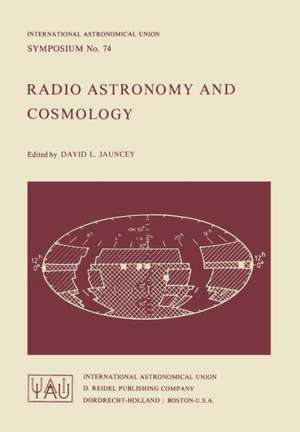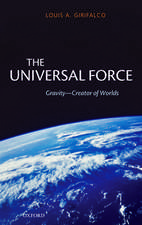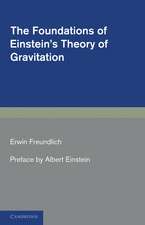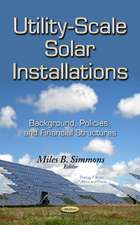Radio Astronomy and Cosmology: International Astronomical Union Symposia, cartea 74
Editat de D.L. Jaunceyen Limba Engleză Paperback – 30 sep 1977
Din seria International Astronomical Union Symposia
-
 Preț: 132.74 lei
Preț: 132.74 lei -
 Preț: 404.67 lei
Preț: 404.67 lei -
 Preț: 400.65 lei
Preț: 400.65 lei -
 Preț: 412.95 lei
Preț: 412.95 lei - 15%
 Preț: 660.68 lei
Preț: 660.68 lei - 15%
 Preț: 654.43 lei
Preț: 654.43 lei -
 Preț: 407.98 lei
Preț: 407.98 lei - 18%
 Preț: 1238.74 lei
Preț: 1238.74 lei - 15%
 Preț: 659.53 lei
Preț: 659.53 lei -
 Preț: 409.89 lei
Preț: 409.89 lei - 18%
 Preț: 1556.77 lei
Preț: 1556.77 lei - 18%
 Preț: 1852.43 lei
Preț: 1852.43 lei - 18%
 Preț: 1235.57 lei
Preț: 1235.57 lei -
 Preț: 419.14 lei
Preț: 419.14 lei -
 Preț: 414.52 lei
Preț: 414.52 lei -
 Preț: 417.41 lei
Preț: 417.41 lei - 15%
 Preț: 647.73 lei
Preț: 647.73 lei - 18%
 Preț: 967.56 lei
Preț: 967.56 lei - 18%
 Preț: 1236.06 lei
Preț: 1236.06 lei -
 Preț: 407.39 lei
Preț: 407.39 lei - 15%
 Preț: 654.12 lei
Preț: 654.12 lei -
 Preț: 416.26 lei
Preț: 416.26 lei - 18%
 Preț: 960.78 lei
Preț: 960.78 lei - 18%
 Preț: 1239.67 lei
Preț: 1239.67 lei - 18%
 Preț: 1239.85 lei
Preț: 1239.85 lei -
 Preț: 416.26 lei
Preț: 416.26 lei -
 Preț: 421.82 lei
Preț: 421.82 lei - 18%
 Preț: 1238.42 lei
Preț: 1238.42 lei -
 Preț: 416.26 lei
Preț: 416.26 lei -
 Preț: 405.28 lei
Preț: 405.28 lei - 18%
 Preț: 1220.54 lei
Preț: 1220.54 lei - 18%
 Preț: 1239.19 lei
Preț: 1239.19 lei - 18%
 Preț: 961.41 lei
Preț: 961.41 lei -
 Preț: 407.39 lei
Preț: 407.39 lei - 18%
 Preț: 961.86 lei
Preț: 961.86 lei - 15%
 Preț: 652.49 lei
Preț: 652.49 lei - 18%
 Preț: 1238.74 lei
Preț: 1238.74 lei - 18%
 Preț: 962.49 lei
Preț: 962.49 lei
Preț: 398.74 lei
Nou
Puncte Express: 598
Preț estimativ în valută:
76.30€ • 78.71$ • 63.67£
76.30€ • 78.71$ • 63.67£
Carte tipărită la comandă
Livrare economică 27 martie-10 aprilie
Preluare comenzi: 021 569.72.76
Specificații
ISBN-13: 9789027708397
ISBN-10: 9027708398
Pagini: 420
Ilustrații: 416 p. 6 illus.
Dimensiuni: 170 x 244 x 22 mm
Greutate: 0.67 kg
Ediția:Softcover reprint of the original 1st ed. 1977
Editura: SPRINGER NETHERLANDS
Colecția Springer
Seria International Astronomical Union Symposia
Locul publicării:Dordrecht, Netherlands
ISBN-10: 9027708398
Pagini: 420
Ilustrații: 416 p. 6 illus.
Dimensiuni: 170 x 244 x 22 mm
Greutate: 0.67 kg
Ediția:Softcover reprint of the original 1st ed. 1977
Editura: SPRINGER NETHERLANDS
Colecția Springer
Seria International Astronomical Union Symposia
Locul publicării:Dordrecht, Netherlands
Public țintă
ResearchCuprins
I. Surveys of Radio Sources, Source Counts and Anisotropies.- The 6C Survey.- Survey of Data for Determining Scales of the Absolute Flux Densities in 10–180 MHz Range and Source Spectra in the Declination Strip 10°–20° (Not presented at Symposium).- Interim Report on the Texas Survey.- The Bologna Survey of Radio Sources at 408 MHz.- The Molonglo Radio Source Surveys at 408 MHz.- Westerbork Surveys of Radio Sources at 610 and 1415 MHz.- The Green Bank Surveys at 1400 MHz.- The Parkes 2700 MHz Survey: Counts of the Sources and their Distribution on the Sky.- Surveys of Radio Sources at 5 GHz.- The Statistical Analysis of Anisotropics.- II. Spectral Index Distributions.- Spectra of Southern Radio Sources.- Spectral Index Studies of Extragalactic Radio Sources.- III. Angular Diameter-Redshift and Flux Density Tests.- Radio Source Angular Sizes and Cosmology.- The Angular Size — Flux Density Relation.- The Flux Density — Angular Size Distribution for Extragalactic Radio Sources.- The Angular Diameter-Redshift Test for Large Redshift Quasars.- The Angular Diameter-Redshift Relation for Scintillating Radio Sources.- IV. Optical Spectra and Identifications.- The Present Status of 3CR Identifications.- QSO Identifications from a Molonglo Radio Survey.- Identifications from the WSRT Deep Surveys.- Luminosity Functions for Extragalactic Radio Sources.- Physical Conditions in Radio Galaxies and Quasars.- Absorption Systems in High Redshift QSO’s.- Relations between the Optical and Radio Properties of Extragalactic Radio Sources.- Relations between Radio and Optical Properties of Radio Sources — Radio Astronomer’s Point of View.- V. Interpretation of Cosmological Information on Radio Sources.- Interpretation of Cosmological Information on Radio Sources.-Cosmological Interpretation of Redshift Data on Quasars through the V/Vmax Test.- Interpretation of Source Counts and Redshift Data in Evolutionary Universes.- The Redshift-Magnitude Relation for Radio Galaxies.- The Hubble Diagrams for Quasars.- Clusters of Galaxies and Radio Sources.- VI. Microwave Background Radiation.- Microwave Background Spectrum — Survey of Recent Results.- Small Scale Fluctuations in the Microwave Background Radiation Associated with the Formation of Galaxies.- Fluctuations in the Microwave Background Caused by Anisotropy of the Universe and Gravitational Waves.- VII. More Interpretation of Cosmological Information on Radio Sources.- The Physics of Radio Sources and Cosmology.- Young Galaxies, Quasars and the Cosmological Evolution of Extragalactic Radio Sources.- Polarization Measurements of Distant Sources.- Rotation Measures and Cosmology.- Cosmological Information from New Types of Radio Observations.- Progress, Problems and Priorities: A Personal View.- Appendix: The Complete Sample of 166 3CR Sources.














